Let’s find out what makes a working Labrador Retriever, and how you can enjoy training your dog to fulfill his natural potential!
He may not know it yet, but lurking inside your Labrador Retriever are a set of instincts that you can have a lot of fun with together. Today we are going to be focusing on the Labrador as a hunting or shooting companion. And also looking at how you can use those ‘retriever’ instincts to help keep your dog fit and happy, and relieve boredom.
There are several hundred pedigree breeds of dog registered by the AKC (in the USA) and the KC (in the UK) and these dogs are divided into separate groups. Each group contains dogs that have certain characteristics in common. In many cases each group is united by a common purpose, the purpose for which the dogs within it, were originally intended.
Your Labrador Retriever falls into the gun dog group, and these origins of these dogs lie in their original role as hunting companions to the men and women who shoot wild animals intended for human consumption.
The gun dog group of dogs
Your Labrador is by definition ‘a retriever’. He belongs to a large and popular sub-group of gun dogs – the retrievers. This group includes the very popular Golden Retriever, and also the Flat-coated retriever, and the Chesapeake Bay Retriever.
All the retriever breeds belong to the gun dog group of dogs and many of them have a closely related history and background, with plenty of genetic links and interbreeding if you go far enough back in time. Over the last hundred years or so, the retrievers have been separated into the distinctive breeds we see today. With Labradors leading the way in the popularity stakes.
Why retrievers are the world’s favorite dogs
The Labrador is the most popular of the retriever breeds, not only as companion dogs in our homes, and as service dogs, but also as hunting companions to those who shoot game and need a dog to retrieve it for them.
Golden Retrievers are also immensely popular and numerous dogs, especially in the USA and these two breeds dominate the pet dog market. The reason that retrievers make such popular and agreeable pets, lies in their origins and purpose. And in the way that they have been bred to work with and co-operate with, human beings.
What was the original role of the working retriever
When guns first came on the scene and changed the face of game hunting, they were cumbersome muzzle loaders and the dogs that worked to the gun were pointers and setters. These dogs hunt vast areas and seek out individual birds, pointing them out to their human companions who can then approach within range to shoot the bird when flushed.
With the advent of faster breech loading guns and the arrival of driven game shooting in the UK, a new type of dog was needed. A day’s shooting could now bag many birds at a time, and with a pair of breech loading guns and a loader, shots could be fired repeatedly. A dog that could remain calm in the midst of such excitement and retrieve bird after bird, without disturbing the game in adjacent strips of land, was required. And so the retriever breeds were developed and bred for this specialised job.
In many parts of the UK, retrievers were never required to hunt up and flush unshot game, this was a job that with the exception of a few areas of open moorland, was gradually taken over by the dual purpose spaniel.
What do working Labradors do today
The principle purpose of the working Labrador Retriever is for the dog to bring shot game back to his owner. Fallen game is often difficult to find and collect, and retrievers are therefore an essential part of this process. Not only to ensure that the hunter gets to eat what he kills, but also to ensure the rapid and humane despatch of any wounded animal.
The role of the working Labrador today varies a little from region to region. We’ll have a look and compare how retrievers are used as hunting companions in the USA, with how they are worked in the UK.
Working Labrador Retrievers in the UK
Working Labradors in the UK can still be found carrying out the same role as they did a hundred years ago, on driven game shoots up and down the land. On a driven shoot, game birds are encourage to flush and fly over the guns by a team of beaters often accompanied by spaniels who help to flush the birds.
The birds are shot by men and women standing on a pre-determined spot marked by a peg or post in the ground. Those doing the shooting are called ‘guns’ and the retrievers that sit next to them waiting to be told to retrieve, are called ‘peg dogs’.
Most of the game shot on the driven shoot is collected by a team of ‘pickers up’. These are people who raise and train their own dogs, work them on shoots, and in some cases compete with them too. These dogs are often predominantly retrievers, though you do find other breeds picking up too.
Other types of UK shooting
Once the preserve of the wealthy and landed gentry, driven shooting is still expensive but it is now popular with people from all backgrounds. And it is possible to buy a single day’s pheasant shooting on a small shoot for an affordable price.
Rough shooting
More popular in the UK is an informal type of shooting known as ‘rough shooting’. This can involve just one person and their dog, or a group of friends and a whole team of dogs. The dogs will hunt in front while the guns walk behind and although this type of hunting is a popular role for the Spaniel, many Labradors are also useful rough shooting dogs.
Wildfowling
Last but not least is the specialised sport of wildfowling where retrievers excel and are indispensable.
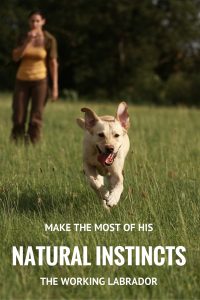
Retrieving over long distances over muddy foreshores in poor light and often swimming equally long distances in cold water, is a job that is best done by a retriever, and Labradors are the retriever of choice for many wildfowlers in the UK
Working retrievers in the USA
In the USA rough shooting is called ‘upland’ and shooting is called hunting. (In the UK the word hunting usually applies to hunting with hounds). The men who carry guns are often called hunters rather than ‘guns’. But much of what we do and expect our dogs to do is the same in both countries.
In England much of the countryside we see today, with little copses nestling into hillsides, was developed for the sole purpose of providing excellent driven game shooting. This is not the case in America, where game shooting has evolved along different lines.
Retrievers are still expected to retrieve, though there may be more emphasis on retrieving from water in large lakes and rivers, or flooded areas where goose and duck hunting is popular. And not only are Labradors popular upland and waterfowl dogs, some American working Labradors actually point, in the manner of the early setters and pointers that our ancestors relied on to find game.
Game is less numerous in open country than it is on an English shooting estate or farm, and pointers and setters are still popular and may be followed on horseback. Despite this, and despite the popularity of the Chesapeake Bay Retriever as a waterfowlers dog, the Labrador now dominates the shooting scene in America, just as it does in the UK.
Could my Labrador be a working retriever
If you admire the strength and courage of these wonderful hunting companions, and if the idea of hunting your own dinner and having your dog swim a river to fetch it for you appeals, you may wonder “Could my dog ever be a working retriever”.
There are a number of retrieving breeds, but the Labrador is by far the most popular and is arguably the best retrieving dog in the world. So much focus has gone into producing this outstanding retriever that even many show bred labradors, still have some retrieving ‘drive’ in there, just waiting to get out. However, your chances of getting your Labrador to a high standard, and perhaps more importantly, of being welcomed into the world of the working gundog, is greater if your dog is from working stock.
Field and Bench Labradors
You may be aware that Labradors have become divided into two different types or strains.
In the USA these are referred to as American (field labs) , and English (bench Labs)
Our original Labradors were bred for perfect function in the shooting field. For their gamefinding ability (so you get to take home what you shoot), for their trainability (so they bring your dinner back and give it to you), and for their soft mouth (so it is fit for the table). They also needed to be tough, athletic, waterproof dogs that could leap gates and fences, swim against a strong current and work in all weather conditions.
Somewhere along the way, we also began breeding dogs for beauty contests, or ‘dog shows’, and over the years a heavier, less agile, shorter legged, Labrador has appeared. The working strains of Labrador are thriving in both America, where they are called American Labs and in the UK where they are called Working, or Field Labs. The Labs that have been bred for the exhibitors bench are known as English in the USA and as Show Labs in the UK.
Your chance of success at retriever training
Your chances of success at training your dog to work effectively in the shooting field will partly depend on which group your own Labrador falls into. Most Labrador Retrievers working successfully as gun dogs in the USA and UK today are field bred. Virtually all Labrador Retrievers competing successfully in field trials in the USA and UK today are field bred.
You can still train your Labrador as a gun dog
This doesn’t mean you cannot train your English / Show lab as a hunting companion, though you may find it a little harder than if your dog is from working lines.
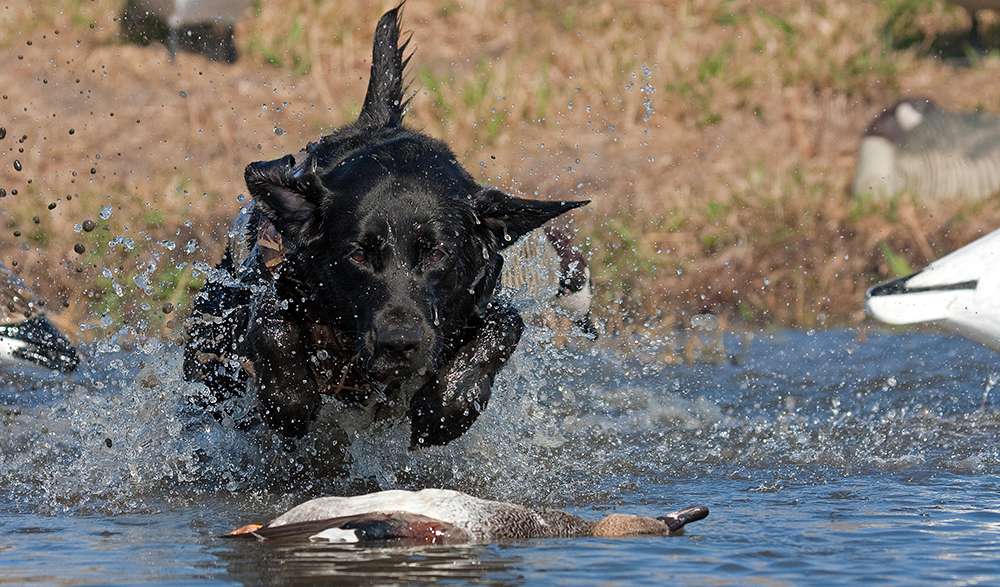
How does gun dog training differ from pet dog training
All gun dog training is built on a foundation of obedience. People sometimes say to me, when talking about their very mischievious Labrador, I think he would have made a great hunting dog. But actually, obedience is even more important in a hunting companion than it is in a pet dog. A really wild dog that has spent the last two years chasing everything in sight, is rarely a suitable candidate for gun dog training
Basic commands such as SIT, HEEL, COME etc. Are taught first and thoroughly proofed. Then comes the fun part where the retriever is taught to ‘handle’ or follow directions given by his handler who may be hundreds of yards away from the dog. In both the USA and the UK those commands are given by whistle and hand signals. However, the way in which these commands are taught has evolved along very different lines in the USA from those used in the Britain.
The main reason that retriever training methods have diverged so widely is the way that Field Trials have diverged in our two regions. So we’ll take a look at that first.
Field trials in the UK
Field Trials in the UK have been largely unchanged for a hundred years. They are still based on the driven pheasant shooting format that our ancestors enjoyed and UK Field Trials take place under live shooting conditions on a genuine shooting day.
This means that each dog will have different types of retrieve to collect. Some will be dead marked birds, some will be blind retrieves, and some will be runners (wounded birds). No two retrieves in any field trial will be the same. The priority of the judges are outstanding game-finding ability, soft mouth, and good manners. Noise of any kind is an eliminating fault. Dogs must be faultlessly calm and obedient.
Field trials in the USA
The lack of driven pheasant shoots in America has meant that Field Trials have evolved along very different lines. Each trial comprises a number of pre-planned retrieves and every dog has to carry out the same retrieves under the same conditions. This means that if dog A has to run two hundred and fifty yards and swim a lake half way, dog B will have to do the same.
In many ways this is a much fairer assessment because the dogs have all had to complete the same task, in others it is a less natural assessment of what happens under genuine shooting conditions.
The impact of ’set-up’ retriever assessments
One of the side effects of this more contrived form of assessment is that retrieves have become longer and more demanding. Handling has become more important than game-finding, and water – which brings added challenges – has become a much more important element of the contest. This development has had a massive impact on training methods. Let’s have a look at that.
Retriever training in the USA
In a long distance retrieving contest where holding a straight line is essential if a dog is to have any chance of being handled accurately onto a bird that is over three hundred yards away, diverging from that straight line has become unacceptable. And to prevent dogs from doing so, a method of correcting dogs at long distances has been essential. This method is of course the controversial e-collar.
Preparation for e-collar training
Now if you just randomly gave an electric shock to a dog two that had no previous experience of an ecollar, when he is headed out to fetch a retrieve, the chances are the result would not be what you want. He might panic and head off in a different direction or he might run back to his handler for reassurance.
So a dog that is going to be trained to handle at a distance with an ecollar needs to be prepared by working with him at close quarters where his reaction to the shock can be controlled. Therefore one of the foundations of US retriever training is to teach a dog how to respond when he feels pain. And what he is taught, is to respond to pain by driving onwards to the retrieve.
This begins with a process called Force Fetch where a pain is applied to the dog’s toe or ear and is released as soon as he grabs a retrieving dummy. Basically the dog learns to switch off pain by grabbing that retrieve.
Although the ecollar is an important part of the training process for American retrievers, once trained, a dog will not normally be shocked on a regular basis, and dogs may not wear ecollars when taking part in a Field Trial. Because handling and straight lines is so important in US trials, many drills and training exercises have been developed to help handlers work on different aspects of handling.
Retriever training in the UK
Because natural game-finding is highly valued in the UK, and retrieves tend to be over shorter distances, Field Trial dogs are not expected to be either lined or handled quite as accurately to every retrieve as they are in the US. The dog is expected to demonstrate his ability to figure things out for himself.
Some UK trainers do complain that retrieves have got longer (though not to the same extent as in the USA) and that there is more emphasis on handling than there should be. But few trainers use retrieving drills and exercises to the extent the US trainers do.
There is another aspect to this too. In the UK all dogs are expected to retrieve naturally. Traditional retriever trainers do not normally teach any kind of forced hold and force fetch training is not used here. In fact, in the England, it would probably be illegal to deliberately cause a dog pain, for any purpose, and there is a strong movement towards banning e-collars permanently.
Relying on a natural retrieve means that retrieve drills, or any exercise that risks putting a dog off retrieving for pleasure, are often avoided. Except by those who teach a ‘trained retrieve’ but in a very different way. Let’s find out about that.
Positive Gundog Training
Although force fetch is rarely used in gun dog training in the UK, there is still a good deal of traditional correction based ‘discipline’ used on British gun dogs. However, in the UK, a small group of gundog trainers have gone even further away from the North American approach and begun training their dogs without the use of aversives or punishment of any kind.
Variously known as force-free, positive-only, aversive free, or positive reinforcement trainers, the positive reinforcement training movement now dominates most dog sports and services, but is only gradually making inroads into the gun dog community in Britain.
One of the benefits of positive reinforcement training is that it offers an option for retrievers that don’t have a good natural retrieve, usually because part of the retrieving chain is missing. But another less talked about benefit is that it enables UK gun dog trainers to use USA retrieving drills, because the dogs have been taught to retrieve for a reward, rather than just for their own personal satisfaction.
How are working retrievers assessed?
Field Trials may be the ultimate test of a working gun dog but they are not the only way of assessing the achievements and capabilities of a retriever. There are a number of other types of assessment, usually considered less demanding and more suitable for the amateur or hobby trainer
Hunt tests in the USA
In America there is a Hunt Test system run by each of the two Kennel Clubs: the American Kennel Club and the United Kennel Club. These are non competitive assessments for gun dogs and they range from the quite basis ‘Junior Hunter’ assessment right the way up to the very challenging top level hunt test titles such as ‘Grand Hunting Retriever Champion’
American Hunt Tests are run under the auspices of both US Kennel Clubs each offering a slightly different set of titles To win a hunt test title for your dog you need to collect a series of ribbons at each level, and the ribbons are awarded for successfully completing the test or assessment at that level.
Field Tests and Working Tests in the UK
In the UK the Kennel Club holds Gundog Working Tests. But unlike the American Hunt Test system, these tests are competitive, just like our Field Trials. GWTs are often (but not always) run on dummies rather than game and can be suitable for the amateur non-shooting gun dog owner. However, the competitive element means that only the best dogs on the day win an award, even if the performance of all the dogs was up to standard.
A system for non-competitive testing using a series of field test along the lines of the USA hunt test system, is run by The Gundog Club.
Getting involved in retriever training and gun dog work
Whether or not you are a hunter, there is still great pleasure to be had from getting involved in retriever training with your Labrador. It will give you a wonderful chance to work with your dog outdoors, to channel his energy and natural instincts into a fulfilling job, and to enjoy watching him achieve his potential. Much of the training can be done using retrieving dummies, so you don’t have to handle dead animals if you don’t want to.
Working and training your dog in the USA
A good place to start in the USA is the North American Hunting Retriever Association. You’ll probably need to join your local club to get the help and support you need. You’ll find contact details for your local clubs on the NAHRA website
If you don’t want to get involved in E collar training there are a few cross over and positive reinforcement trainers in the US – a good place to meet up with them is on the Positive Gundogs facebook group
Working and training your dog in the UK
The shooting community in the UK is not always easy to ‘break into’. One of the best ways to do so is to offer to help out on a shoot during the summer, or to spend some time with a professional gun dog trainer. If you are a complete newcomer the Gundog Club is a great place to begin. It has a graded training scheme that takes the novice in easy steps through each of the stages of gundog training, and a list of Accredited Trainers for those who would like some lessons.
Once you have reached Grade Four, you can think about actually taking part in some shooting activities You can read more about training your dog and getting into shooting on the Totally Gundogs website.
Before you begin gun dog training
There is an old saying that “the best way to ruin a good dog, is to take it shooting”. And there is a grain of truth in this. A shoot day is a very exciting event for a dog. Do not attempt to join in such an occasion until you have ensured that your dog is comfortable with gunfire, has some basic training, and is ‘steady’ (won’t chase) to game.
Like any social group, the shooting community has it own peculiar set of customs and traditions. In the UK, you are expected to dress ‘somberly’ on a shoot day. Bright colours are somewhat frowned upon, and you will find most beaters and pickers up wear a muddy shade of green or khaki.
In the USA hunters take a different approach and often wear bright orange so that other hunters can easily identify them. If you want to get involved in your local shooting community, the secret is to make yourself helpful and be willing to learn their rules and customs.
Summary
The Labrador Retriever’s original purpose is to collect shot animals and birds, and to carry these gently and safely home to his master or mistress. Retrievers are trained using plastic retrieving dummies and most Labradors will enjoy retriever training even if they are not capable of winning a competition. Getting involved in retriever training and in working your dog is a wonderful outdoor past-time which will help keep you and your four legged friend fit, and happy.
More information

Is your Labrador a working retriever? Does he have any titles? Let us know what you and he have achieved in the comments box below
The Working Retriever was first published in 2011 and has been extensively revised and updated for 2016
Readers Also Liked
- Should You Buy a Dog Whistle?
- History of the Labrador Retriever
- Different Types of Labrador
- How to Train a Dog to Come
- Teaching a Dog to Heel
- Train a Puppy or Dog to Come
- Labrador Recall Proofing
References and Resources
- ‘Rough Shooting in the UK‘, Totally Gundogs (2011)
- ‘Wildfowling‘, Totally Gundogs (2011)
The Labrador Site Founder
Pippa Mattinson is the best selling author of The Happy Puppy Handbook, the Labrador Handbook, Choosing The Perfect Puppy, and Total Recall.
She is also the founder of the Gundog Trust and the Dogsnet Online Training Program
Pippa's online training courses were launched in 2019 and you can find the latest course dates on the Dogsnet website

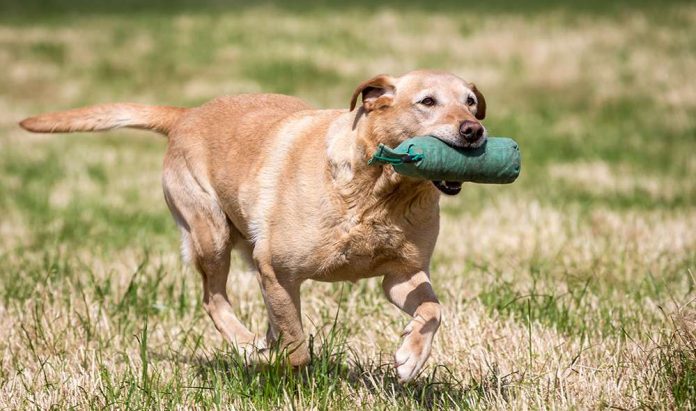




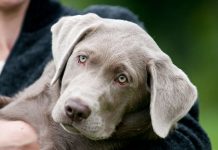
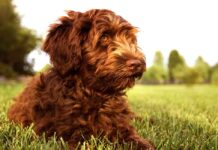
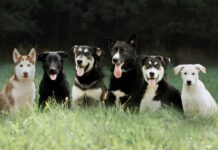
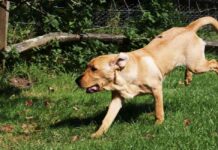
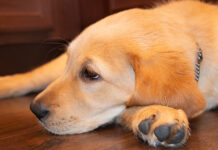








Are there any drills to break a dog from hard mouth?. He is a little rough when he retrieves.
How old is your dog Craig?
I’ve inherited a 6 1/2 year old Chocolate lab. We LOVE this guy. But he’s gun shy & very needy. When I let my mini Doxie & Chihuahua out for potty time. I have to go out and basically babysit. If He can’t visibly see me, he’s at the door knocking. He’s house trained, thank goodness, but when it’s cold, I suffer & he loves it. So, I look life Alfie on the Christmas Story movie outside waiting for him to do what he’s gotta do. How can I stop this action/behavior without hurting his feelings and breaking my heart. How do we transition him out of his fear of gunshots fired? Not just when we hunt, but also neighboring property. We hunt our property & he wants nothing to do with that loud sound. My Chihuahua is all over it though.
This is how I cured my gun shy dog Sue Ellen. You may find it helpful http://totallygundogs.com/gunshy-dog-can-it-ever-be-cured/
Hi Pippa,
I am facing a problem with me new 7 week old female labrador. She doesnt respond to sounds much. I tried calling her and banging things but she doesnt respond. One thing is that when i lock her up in her cage, she weans and then if i call her she would respond.
kindly help.
My lab does not barked when seeing others?? Why??
Hi Adesh,
Labradors aren’t meant to be guard dogs. Many don’t bark very much at all. I think this is a good thing 🙂
Pippa